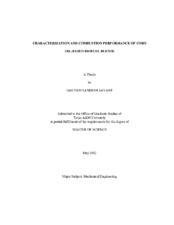| dc.description.abstract | In recent years, the development and use of biofuels have received considerable attention due to the high demand for environmentally acceptable (green) fuels. Most of the recent studies have looked at the processes of converting vegetable oils into biodiesel. It is well known vegetable oil to biodiesel conversion involves many processes including transesterification, which makes biodiesel costly and time-consuming to produce. In this study, the effects of blending high-viscosity fresh and used corn oils with low-viscosity diesel and jet fuel mixed with butanol and ethanol were studied. Several corn oil-based blends were formulated and characterized to understand the effect of composition on viscosity, fuel stability and energy content. The formulated corn oil blends were combusted in a 30 kW modified combustion chamber to determine the corresponding NOx and CO emission levels, along with CO₂ levels. Used corn oil was made by simply heating fresh corn oil for a fixed period of time (about 44 hours), and was characterized by quantifying its total polar material (TPM), iodine value, free fatty acid content, and peroxide value. The combustion experiments were conducted at a constant heat output of 68,620 kJ/hr (19 kW), to observe and study the effects of equivalence ratio, swirl number, and fuel composition on emissions. Used corn oil blends exhibited better combustion performance than fresh corn oil blends, due in part to the higher unsaturation levels in fresh corn oil. NOx emissions for used corn oil increased with swirl number. Among all the blends, the one with the higher amount of diesel (lower amount of corn oil) showed higher NOx emissions. The blend with fresh corn oil showed decreasing NOx with increasing equivalence ratio at swirl number 1.4. All blends showed generally decreasing CO trends at both swirl numbers at very lean conditions. The diesel fuel component as well as the alcohols in the blends were also important in the production of pollutants. Compared to the diesel-based blends mixed with used corn oil, butanol, and ethanol, the jet fuel-based blends showed higher NOx levels and lower CO levels at both swirl numbers. | en |


